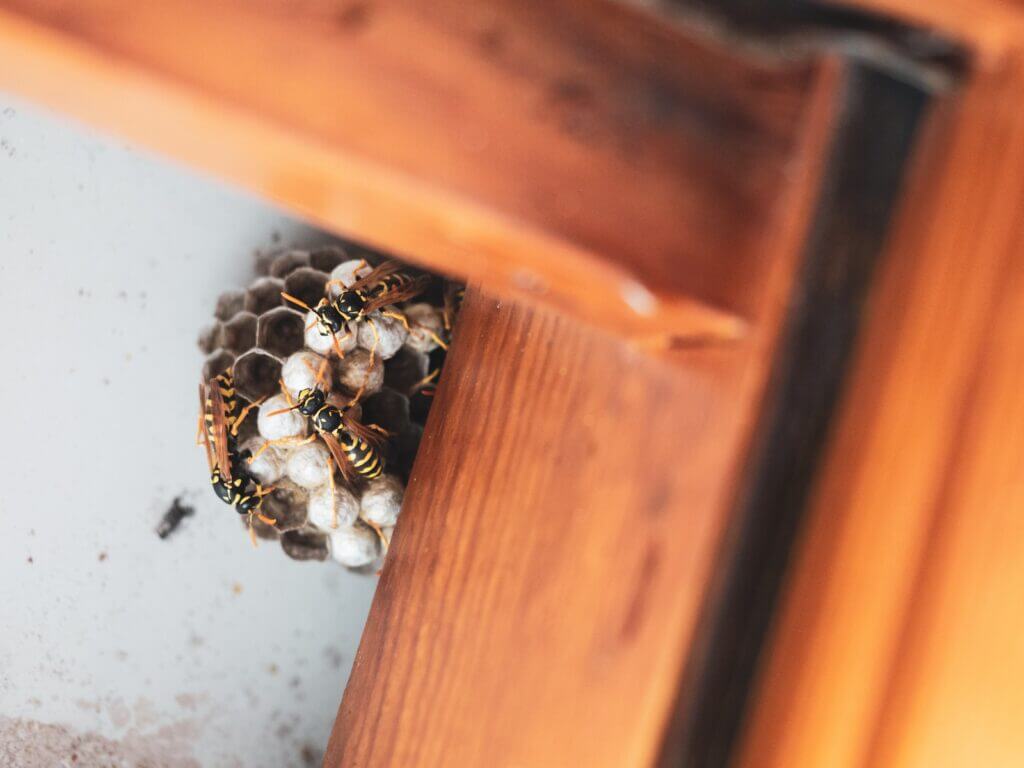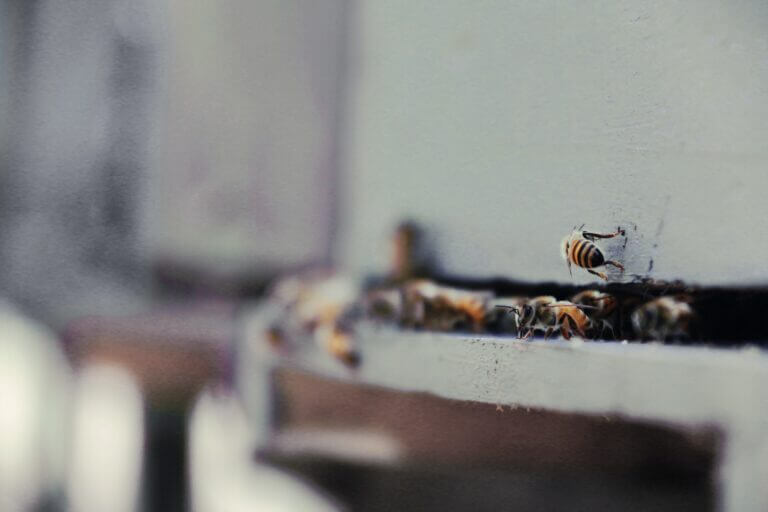Finding bees in your roof can be alarming at first. But bees are an essential part of our ecosystem, so getting rid of them safely and humanely is crucial. This article covers everything you need to know about identifying bee hives in your roof, the benefits of having them on your property, and how to remove them without harm if they do become a nuisance.
How to Tell if You Have Bees in Your Roof

The first signs of bees in your roof are often auditory—you may hear a faint buzzing noise coming from the attic or upper walls. Some other telltale signs include:
- Honeybees entering or exiting the roof through small cracks or openings. Look for increased bee traffic on the exterior.
- Wax debris on the ground below roof overhangs. Bees shed scraps when constructing honeycomb inside.
- Honey drippings or staining on the exterior. Hives sometimes leak.
- Increased activity from other pollinators like wasps, drawn by the honeybee hive.
- A musty, honey-like smell around the structure.
You may also hear louder hums coming from the walls as the colony gets larger. If you suspect a hive inside the roof, call a professional beekeeper for an inspection. Never disturb the bees yourself.
The Benefits of Letting Roof Bees Stay
Before jumping to get rid of roof bees, consider the benefits of having them on your property:
- Pollination for your garden and crops. Honeybees are crucial pollinators. They fertilize flowers and increase yields of fruits, nuts and vegetables in nearby gardens.
- Honey production. With proper equipment, you can harvest fresh honey from a roof-based hive, if done sustainably.
- Educational opportunities. Beekeeping is a fascinating hobby. Hive inspections teach children about nature and agriculture.
- A boost for the ecosystem. Honeybees are vitally important and their populations are declining. Providing them a safe habitat supports the local ecosystem.
As long as the bees don’t interfere with living areas, most experts recommend tolerance and coexistence with roof-dwelling honeybees. Protect this vital species.
When Removal is Necessary: Signs of a Problem Hive
However, sometimes honeybee hives in roofs do require removal, especially if:
- The hive expands into living spaces. This poses a stinging risk. Hives that access interior walls need removal.
- Significant honey drips or wax debris build up. This can allow moisture damage and rot in roof structures over time.
- The colony exhibits aggressive behavior. Africanized hybrid honeybees are more defensive and likely to sting.
- You’re severely allergic to stings. Proximity to the hive puts you at medical risk.
Call a professional once a roof-dwelling hive becomes a nuisance, health threat, or causes structural damage. Otherwise, let the bees be.
How to Get Rid of Bees in the Roof Safely and Humanely
If a difficult hive does need removing, avoid DIY methods like smoke bombs, sprays, or other techniques that can kill bees. Bee populations are in decline, so call an ethical bee removal service.
Here’s how professional beekeepers safely remove unwanted roof hives:
Inspection and Preparation
- The beekeeper will first visually inspect the roof to find hive entry points and estimate the colony’s size. This determines removal needs.
- Nearby flowering plants that attract bees will be removed so returning foragers don’t interfere with removal work.
- The beekeeper will plan removal access points and sealing methods after inspection.
- Most extractions happen at night when all foragers are home. This ensures the queen and majority of bees can be captured.
Gentle Hive Removal Procedures
- First, the main combs are exposed by opening roof access panels or exterior siding. Combs are gently cut or detached from roof structures.
- Bees are brushed off each honeycomb into a ventilated collection box kept nearby. This captures the queen, workers and brood while minimizing stress on the colony.
- If needed, bee vacuum devices with soft brushes gently pull straggling bees off without harming them.
- Once the hive is fully removed, the beekeeper seals roof gaps so a new colony doesn’t take its place. Exclusion materials like wire mesh are installed.
Post Removal Care and Relocation
- The relocated roof-dwelling colony is brought to the beekeeper’s apiary or given to a beekeeping mentor to adopt.
- Hives are assessed for health and given supplemental food if needed to boost recovery.
- Once stable in their new home, these rescued bees can start producing honey again or be used for educational purposes.
A professional bee removal service will humanely capture an entire roof hive including the queen and rehome them without harm. This preserves local honeybee populations.
DIY Bee Removal Tips (Only in Emergencies!)
While professional removal is highly recommended, there are some DIY tricks to try in a pinch if you can’t get a beekeeper on site quickly:
- Attract the bees out: Place a dish of sugar water laced with honey far from the hive entrance. The scent can lure some foragers away from the roof temporarily.
- Use a bee vacuum: Special vacuums with soft brushes can pull bees off honeycomb without crushing them, but this stresses colonies. Call a pro ASAP.
- Avoid killing sprays or dusts: Never use pesticides on honeybees! They are essential pollinators.
- Remove attractive plants: Bees forage on flowering plants near the hive. Eliminating these temporarily forces bees to look further afield for nectar and pollen.
- Exclude entry points: Seal exterior gaps around chimneys, vents and siding that bees use to enter the roof. Use mesh, caulk, wood, expanding foam or metal flashing. But this traps bees inside, so get professional removal help fast!
- Wait it out: Given enough time, bees often relocate rather than expand their roof nest. But keep monitoring the situation.
With DIY exclusion techniques, act fast to get a beekeeper’s assistance so the colony can be captured humanely. Avoid harming the bees at all costs.
Why Kill Bees When You Can Keep Them? Adopt a Roof Hive!
Rather than automatically exterminating roof hives, consider having them relocated to an apiary so you can enjoy the benefits of beekeeping:
- Fresh honey and beeswax harvests each season
- Incredible pollination power for gardens and crops
- A closer look into the fascinating world of bees
- Knowing you’re helping sustain an ecologically vital species
Backyard beekeeping is easier than ever for beginners. Buy a bee suit and equipment, then have a bee removal pro safely capture the roof colony and move it into a hive box on your property. Welcome honeybees as helpful guests rather than pests! They offer gifts if treated well.
Coexisting Peacefully with Roof-Dwelling Bees
In many cases, bees in the roof don’t need to be confronted at all. Follow these tips to coexist safely:
- Watch for signs of aggression. Defensive behavior means it’s time to call for removal.
- Avoid roof cavities where hives could expand into living spaces. Attic insulation deters bees from moving in.
- Seal exterior cracks where bees enter, but leave the main hive alone if it’s not a nuisance.
- Place sweet‐smelling plants away from the house to keep foragers away from high-traffic doors or windows.
- Install bee houses around your yard for non-hive nesters like mason bees. Give all pollinators a safe haven.
Honeybees are valuable assets. With proper precautions, roof-dwelling hives can be left undisturbed or adopted as a fascinating backyard science project. Welcome bees onto your property as helpful contributors rather than pests. Their ecosystem services far outweigh the hassle of removal. Protect their populations for the good of nature, food chains, and human agriculture alike.





We have just recently found a lot of honey bees around our property just starting yesterday 13th may! we live in a semi detatched bungalow and at the end of our roof we noticed a lot of activity, i thought it was wasps at first, i had a pest control guy over to check it out and he said it was honey bees, my wife loves flowers and they are everywhere in our back and front garden and on our back decking so im sure they are attracted to them as well, the pest control guy said he cant do anything but leave it for a week to see how things go, they are not in our loft as far as i can see and our loft is heavilly insulated, any advice on what we could do if it does get worse?